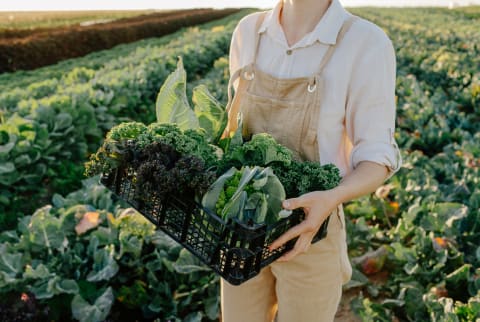Advertisement
Regenerative Farms Boast Healthier Crops & Soil Than Conventional Farms



Unlike environmentally damaging growing practices used by commercial farms, regenerative agriculture improves the sustainability of the land to ensure farming can continue for years to come. Additionally, many have theorized that regenerative farming significantly increases the quality of food, but not much evidence has been available to support this theory—that is, until a nationwide study on regenerative farms was recently published in PeerJ.
What is regenerative agriculture?
Regenerative agriculture (aka regenerative farming) is a holistic, sustainable approach to farming that aims to restore the nutrient content of the soil with conservation and rehabilitation measures.
Regenerative farming operates on five principles:
- Minimize or eliminate soil disturbances (e.g., tillage—the practice of overturning the soil to get rid of weeds and pests).
- Keep the topsoil rich and healthy with vegetation (e.g., cover crops).
- Increase biodiversity of plants to increase the soil's nutrient value and support local wildlife.
- Keep living roots in the soil year-round so there is a constant supply of carbon enriching the soil.
- Integrate livestock on your land to fertilize the soil and increase the organic soil matter (which serves as a reservoir of nutrients for plants to utilize).
By implementing systems to promote soil resilience, integrity, and well-being, regenerative farmers are supporting the environment, ecosystem, and their local communities with the food they produce or raise. (Learn how we can do our part to support regenerative farmers here.)
4 ways this study showed regenerative farming produces more nutritious food.
While the regenerative agriculture movement is certainly gaining traction, researchers haven't been able to quantify the positive outcomes from implementing these sustainable, soil-enriching practices until now.
The PeerJ study compared the soil health and nutrient density of crops at regenerative and conventional farms in eight different states across the country. Each regenerative farm was paired with a conventionally managed farm close by.
Both grew the same type of crop in the same kind of soil, then sent their crops to the Linus Pauling Institute at Oregon State University to be evaluated for B vitamins (specifically, thiamin, riboflavin, niacin, pantothenic acid, and B6), plus vitamins C, E, and K, as well as a slew of minerals (including magnesium, iron, sodium, phosphorous, calcium, copper, and zinc) and phytochemicals (i.e., total phenols, total phytosterols, and total carotenoids).
Here's what the study found:
- On average, regenerative farms that use cover crops, crop rotation, and minimal tilling produce crops with better soil health (seven times healthier than conventional farms) and higher levels of vitamins K and E, thiamin, riboflavin, calcium, copper, sodium, and phosphorus.
- Veggies from regenerative no-till farms have higher levels of phytochemicals (i.e., total phenols, total phytosterols, and total carotenoids) than veggies grown conventionally and sold in supermarkets.
- Regenerative no-till crops of wheat have a higher density of mineral micronutrients than conventional no-till crops.
- Beef and pork raised on regenerative farms have three and nine times more omega-3 fats (i.e., ALA, EPA, DPA, and DHA), respectively, and a healthier ratio of omega-6 to omega-3 fats than conventional meat from the supermarket.
The takeaway.
This groundbreaking study confirms what we at mbg have known all along to be true: Regenerative farming is better for the environment and our health. While the type and quantity of nutrients varied by crop and farm, the nutritional value of crops produced with regenerative practices was profoundly higher than those farmed conventionally.
It's also worth noting that the soil health significantly affected the phytochemical levels of the produce. Healthier soil resulted in dramatically higher phytochemical content, which positively affects our nutrition by promoting immune health and longevity. While the research in this field is ongoing, the evidence shown in this preliminary study indicates that regenerative agriculture has the potential to restore the nutritional quality of our food if implemented properly.
Until more farms are operating sustainably and regeneratively grown food becomes widely accessible, it's important to make sure you're getting the essential nutrients you need (and may not be getting as easily from your food, thanks to conventional farming). Consider adding a comprehensive, high-potency multivitamin (that also features an array of phytonutrients) like mbg's ultimate multivitamin+ to your daily routine to ensure your dietary needs are met, no matter where your food is coming from.*
